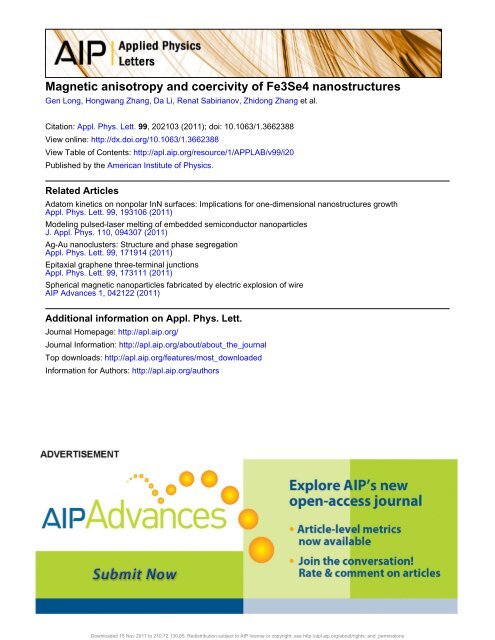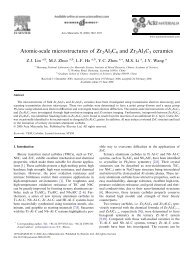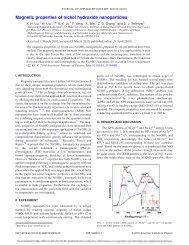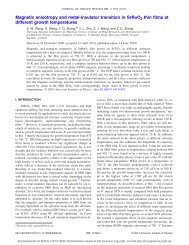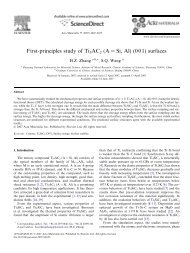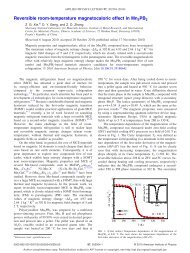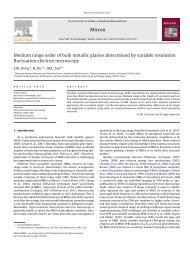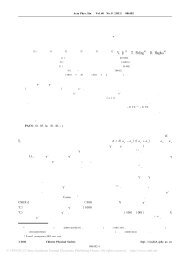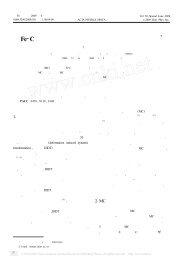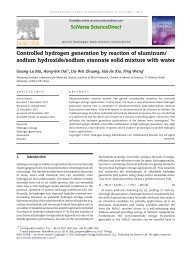Magnetic anisotropy and coercivity of Fe3Se4 nanostructures
Magnetic anisotropy and coercivity of Fe3Se4 nanostructures
Magnetic anisotropy and coercivity of Fe3Se4 nanostructures
You also want an ePaper? Increase the reach of your titles
YUMPU automatically turns print PDFs into web optimized ePapers that Google loves.
<strong>Magnetic</strong> <strong>anisotropy</strong> <strong>and</strong> <strong>coercivity</strong> <strong>of</strong> <strong>Fe3Se4</strong> <strong>nanostructures</strong><br />
Gen Long, Hongwang Zhang, Da Li, Renat Sabirianov, Zhidong Zhang et al.<br />
Citation: Appl. Phys. Lett. 99, 202103 (2011); doi: 10.1063/1.3662388<br />
View online: http://dx.doi.org/10.1063/1.3662388<br />
View Table <strong>of</strong> Contents: http://apl.aip.org/resource/1/APPLAB/v99/i20<br />
Published by the American Institute <strong>of</strong> Physics.<br />
Related Articles<br />
Adatom kinetics on nonpolar InN surfaces: Implications for one-dimensional <strong>nanostructures</strong> growth<br />
Appl. Phys. Lett. 99, 193106 (2011)<br />
Modeling pulsed-laser melting <strong>of</strong> embedded semiconductor nanoparticles<br />
J. Appl. Phys. 110, 094307 (2011)<br />
Ag-Au nanoclusters: Structure <strong>and</strong> phase segregation<br />
Appl. Phys. Lett. 99, 171914 (2011)<br />
Epitaxial graphene three-terminal junctions<br />
Appl. Phys. Lett. 99, 173111 (2011)<br />
Spherical magnetic nanoparticles fabricated by electric explosion <strong>of</strong> wire<br />
AIP Advances 1, 042122 (2011)<br />
Additional information on Appl. Phys. Lett.<br />
Journal Homepage: http://apl.aip.org/<br />
Journal Information: http://apl.aip.org/about/about_the_journal<br />
Top downloads: http://apl.aip.org/features/most_downloaded<br />
Information for Authors: http://apl.aip.org/authors<br />
Downloaded 15 Nov 2011 to 210.72.130.85. Redistribution subject to AIP license or copyright; see http://apl.aip.org/about/rights_<strong>and</strong>_permissions
APPLIED PHYSICS LETTERS 99, 202103 (2011)<br />
<strong>Magnetic</strong> <strong>anisotropy</strong> <strong>and</strong> <strong>coercivity</strong> <strong>of</strong> Fe 3 Se 4 <strong>nanostructures</strong><br />
Gen Long, 1 Hongwang Zhang, 1 Da Li, 1,2 Renat Sabirianov, 3 Zhidong Zhang, 2<br />
<strong>and</strong> Hao Zeng 1,a)<br />
1 University at Buffalo, the State University <strong>of</strong> New York, Buffalo, New York 14260, USA<br />
2 Shenyang National Laboratory for Materials Science, Institute <strong>of</strong> Metal Research <strong>and</strong> International Center<br />
for Materials Physics, Chinese Academy <strong>of</strong> Sciences, Shenyang, Liaoning 110016, China<br />
3 University <strong>of</strong> Nebraska-Omaha, Omaha, Nebraska 68182, USA<br />
(Received 10 August 2011; accepted 23 October 2011; published online 15 November 2011)<br />
The hard magnetic properties <strong>of</strong> Fe 3 Se 4 <strong>nanostructures</strong> were studied both experimentally <strong>and</strong><br />
theoretically. <strong>Magnetic</strong> measurements showed that Fe 3 Se 4 nanoparticles can exhibit giant <strong>coercivity</strong><br />
exceeding 40 kOe at low temperature (10 K). This unusually large <strong>coercivity</strong> is attributed to the<br />
uniaxial magnetocrystalline <strong>anisotropy</strong> <strong>of</strong> the monoclinic structure <strong>of</strong> Fe 3 Se 4 with ordered cation<br />
vacancies. The measured <strong>anisotropy</strong> constant is 1.0 10 7 erg/cm 3 , consistent with the result from<br />
first-principles calculations. The magnetization reversal mechanism <strong>of</strong> the nanoparticles is found to<br />
be incoherent spin rotation. VC 2011 American Institute <strong>of</strong> Physics. [doi:10.1063/1.3662388]<br />
Fe 7 Se 8 <strong>and</strong> Fe 3 Se 4 are two iron chalcogenide compounds<br />
known to be ferrimagnetic half-a-century ago. 1–5<br />
The ferrimagnetism is attributed to the ferromagnetically<br />
aligned spins within the c-plane coupled antiferromagnetically<br />
between adjacent planes with ordered iron vacancies. 6,7<br />
The <strong>nanostructures</strong> <strong>of</strong> these compounds, on the other h<strong>and</strong>,<br />
are less studied. 8,9 The lower dimensionality provides additional<br />
tuning capabilities for their magnetism. Two very<br />
recent work reported the synthesis <strong>and</strong> magnetic properties<br />
<strong>of</strong> Fe 7 Se 8 <strong>and</strong> Fe 3 Se 4 <strong>nanostructures</strong> <strong>and</strong> positive magnetoresistance<br />
in one-dimensional Fe 3 Se 4 nanowire arrays. 10,11<br />
However, the magnetic <strong>anisotropy</strong> in these materials,<br />
whether in bulk form or in <strong>nanostructures</strong>, is poorly known.<br />
In this work, we report the magnetic properties <strong>of</strong> chemically<br />
synthesized Fe 3 Se 4 <strong>nanostructures</strong>. By reducing the dimension<br />
<strong>of</strong> Fe 3 Se 4 , giant <strong>coercivity</strong> values <strong>of</strong> 40 kOe have been<br />
realized at low temperatures. Such a large <strong>coercivity</strong> has not<br />
been reported previously in Fe 3 Se 4 or in any other assynthesized<br />
magnetic systems. The magnetic <strong>anisotropy</strong> is<br />
measured to be 1.0 10 7 erg/cm 3 , which is confirmed by our<br />
first-principles computation results. It is rare for materials<br />
without rare earth or noble metal elements to possess such<br />
high <strong>anisotropy</strong>. Its origin is attributed to the monoclinic<br />
structure <strong>of</strong> Fe 3 Se 4 with ordered iron vacancies.<br />
Fig. 1(a) shows the magnetic hysteresis loops <strong>of</strong> the<br />
Fe 3 Se 4 nanoparticles synthesized by our chemical solution<br />
method. 12 The nanoparticles have a shape <strong>of</strong> faceted nanoplatelets<br />
with average sizes <strong>of</strong> 100 nm. The paramagnetic<br />
slope at high fields can be attributed to spin canting at the<br />
grain boundaries <strong>and</strong> particle surfaces. Assuming that spins<br />
in the particle interior remain collinear <strong>and</strong> reach saturation,<br />
we can subtract the paramagnetic component from the magnetic<br />
hysteresis to extract the behavior <strong>of</strong> the ferrimagnetic<br />
component including its saturation magnetization (M S ) <strong>and</strong><br />
<strong>coercivity</strong> (H c ). M S is 2.2 emu/g at 293 K which increases<br />
to 12.6 emu/g at 10 K. The M S value <strong>of</strong> 12.6 emu/g<br />
(83 emu/cm 3 ) corresponds to 2.2 l B per unit cell (defined as<br />
Fe 6 Se 8 ) <strong>and</strong> is close to earlier experimental results. 5 The<br />
a) Electronic mail: haozeng@buffalo.edu.<br />
most striking behavior <strong>of</strong> these nanoparticles is their giant<br />
<strong>coercivity</strong> observed. It can be seen that H c reaches 4 kOe at<br />
room temperature, which rises by an order <strong>of</strong> magnitude to<br />
40 kOe at 10 K (Fig. 1(a)).<br />
To investigate the origin <strong>of</strong> such a large <strong>coercivity</strong>, the<br />
magnetic <strong>anisotropy</strong> is measured using powderized bulk<br />
samples partially aligned in a magnetic field. As can be seen<br />
from the inset <strong>of</strong> Fig. 1(b), the predominant diffraction peak<br />
is (020) for the aligned sample, indicating that the easy axis<br />
is the b-axis. The hexagonal symmetry <strong>of</strong> NiAs-based FeSe<br />
crystal structure is dictating the symmetry axis to be along<br />
its 6-fold symmetry c-axis. However, vacancies in Fe 3 Se 4<br />
order in chains along the b-axis. Because <strong>of</strong> this, the symmetry<br />
<strong>of</strong> the lattice reduces to monoclinic <strong>and</strong> the b-axis<br />
becomes the easy axis. This also suggests that magnetocrystalline<br />
<strong>anisotropy</strong> is responsible for the observed <strong>anisotropy</strong><br />
<strong>and</strong> large <strong>coercivity</strong>. This is underst<strong>and</strong>able since the shape<br />
<strong>of</strong> the <strong>nanostructures</strong> is more or less isotropic with small aspect<br />
ratio, <strong>and</strong> also the magnetization <strong>of</strong> the material is low,<br />
leading to negligible contribution from the shape <strong>anisotropy</strong>.<br />
The magnetic <strong>anisotropy</strong> constant (K u ) can be obtained by<br />
extrapolating the magnetic hysteresis loops in both the easy<br />
<strong>and</strong> hard axes directions. As an example, Fig. 1(b) shows the<br />
hysteresis loops parallel <strong>and</strong> perpendicular to the easy axes,<br />
measured at 10 K. Note that while the powder sample has<br />
much smaller <strong>coercivity</strong> than that <strong>of</strong> the nanoparticles, their<br />
<strong>anisotropy</strong> values should be comparable since K u is primarily<br />
a material property. From the measured M s <strong>and</strong> extrapolated<br />
<strong>anisotropy</strong> field (H K ), the magnetic <strong>anisotropy</strong> constant K u<br />
can be calculated using K u ¼ 1 2 M SH K . To determine the type<br />
<strong>of</strong> the magnetocrystalline <strong>anisotropy</strong>, temperature dependence<br />
<strong>of</strong> K u was measured (Fig. 2(a)). For uniaxial magnetocrystalline<br />
<strong>anisotropy</strong>, K u should be proportional to M 3 S ;<br />
while for cubic type, K u should be proportional to M 10 s . 13<br />
Fig. 2(b) shows a plot <strong>of</strong> K u as a function <strong>of</strong> M s (log-scale).<br />
A linear fitting gives a slope <strong>of</strong> 2.6, which indicates that the<br />
<strong>anisotropy</strong> is predominantly uniaxial. 13<br />
The large K u <strong>of</strong> 1.1 10 7 erg/cm 3 at 10 K is non-trivial<br />
since the material does not contain any rare-earth or noble<br />
metal element. This makes Fe 3 Se 4 st<strong>and</strong>ing out as a<br />
0003-6951/2011/99(20)/202103/3/$30.00 99, 202103-1<br />
VC 2011 American Institute <strong>of</strong> Physics<br />
Downloaded 15 Nov 2011 to 210.72.130.85. Redistribution subject to AIP license or copyright; see http://apl.aip.org/about/rights_<strong>and</strong>_permissions
202103-2 Long et al. Appl. Phys. Lett. 99, 202103 (2011)<br />
TABLE I. Calculated MAE <strong>and</strong> orbital moments (per unit cell) <strong>of</strong> Fe 3 Se 4 .<br />
a b c<br />
MAE 1.139 meV 0 2.051 meV<br />
Orbital moments 0.16 0.19 0.1<br />
Note: using lattice parameters a ¼ 6.208, b ¼ 3.525, <strong>and</strong> c ¼ 11.28326 A ;<br />
1 meV/unit cell ¼ 0.6 10 6 erg/cm 3 .<br />
FIG. 1. (Color online) (a) The hysteresis loops <strong>of</strong> faceted Fe 3 Se 4 nanoparticles<br />
at 10 K <strong>and</strong> room temperature <strong>and</strong> (b) the hysteresis loops <strong>of</strong> a partially<br />
aligned Fe 3 Se 4 powder sample measured parallel <strong>and</strong> perpendicular to the<br />
easy axis at 10 K. The inset shows that the predominant diffraction peak is<br />
(020).<br />
c<strong>and</strong>idate for hard magnetic material applications, especially<br />
when large magnetization is not needed (e.g., in recording<br />
media). 14 The origin <strong>of</strong> the large <strong>anisotropy</strong> is rooted in its<br />
crystal symmetry: Fe 3 Se 4 is in a monoclinic structure, with<br />
ordered Fe vacancies along the b-axis. This vacancy ordering<br />
produces highly anisotropic crystal field <strong>and</strong> the spin-orbit<br />
coupling thus leads to prominent magnetocrystalline <strong>anisotropy</strong>.<br />
To verify this, we performed first-principles calculations<br />
<strong>of</strong> the magnetocrystalline <strong>anisotropy</strong> energy (MAE) <strong>of</strong><br />
Fe 3 Se 4 using the projector augmented-wave (PAW) method<br />
<strong>and</strong> its implementation in the Vienna ab-initio simulation<br />
package (VASP) code within the Perdew-Burke-Ernzerh<strong>of</strong><br />
(PBE) generalized gradient approximation. The lattice parameters<br />
<strong>and</strong> the atomic positions were taken from the experimental<br />
data. The calculations were performed without<br />
symmetry operations <strong>and</strong> with 9 16 5 division <strong>of</strong> Brillouin<br />
zone.<br />
The results <strong>of</strong> the calculation are presented in Table I. The<br />
calculated easy axis is b <strong>and</strong> the MAE is <strong>of</strong> the order <strong>of</strong><br />
1.2 10 7 erg/cm 3 . These are in agreement with experimental<br />
findings. The magnetic structure <strong>of</strong> the compound in the<br />
ground state is ferrimagnetic. The calculated difference in<br />
energy <strong>of</strong> the ferromagnetic <strong>and</strong> ferrimagnetic structures is<br />
0.447 eV/unit cell. The total magnetic moment per unit cell<br />
(Fe 6 Se 8 )is4.34l B (4.15 l B spin moment). This value is nearly<br />
twice as large as the experimental value <strong>of</strong> 2.2 l B /unit cell. In<br />
ferrimagnetic materials, the total magnetization is obtained<br />
from the difference <strong>of</strong> two large magnetization values in sublattices<br />
<strong>and</strong> somewhat larger discrepancies can be expected compared<br />
with the computational results for ferromagnetic<br />
systems. Ma et al. 15 argue that in a-FeSe the corresponding<br />
long-range ordering moment measured by experiments should<br />
be smaller than the calculated one, because the calculations are<br />
done based on the magnetic unit cell <strong>and</strong> the low-energy spin<br />
fluctuations, as well as their interactions with itinerant electrons<br />
are frozen by the finite-size excitation gap.<br />
Coercivity depends on both magnetic <strong>anisotropy</strong> <strong>and</strong> the<br />
magnetization reversal mechanisms. To see whether our particles<br />
are multi-domain or single-domain, we estimate the<br />
critical radius for a single-domain particle following:<br />
r C 9 ðAK uÞ 1=2<br />
pMS<br />
2 ; (1)<br />
where A is the exchange stiffness constant. 13 A is unknown<br />
experimentally for Fe 3 Se 4 , <strong>and</strong> thus calculated from firstprinciples<br />
by linear muffin-tin orbital method (LMTO) using<br />
analytical formula derived in the frame <strong>of</strong> second-order perturbation<br />
expansion. 16,17 Results <strong>of</strong> exchange parameters are<br />
shown in Table II. The exchange coupling in the plane is<br />
mainly ferromagnetic while that between the planes is antiferromagnetic.<br />
The exchange stiffness can then be estimated<br />
using<br />
D ¼ 2l B<br />
3M<br />
X<br />
J ij R 2 ij : (2)<br />
TABLE II. Calculated pair exchange parameters <strong>of</strong> Fe 3 Se 4 .<br />
j<br />
Pair (types) J ij (mRy) R ij (A )<br />
FIG. 2. (Color online) (a) The measured K u as a function <strong>of</strong> temperature<br />
<strong>and</strong> (b) K u as a function <strong>of</strong> M S plotted in the logarithmic scale. The line is a<br />
linear fitting giving a slope <strong>of</strong> 2.6. The errors in the measurements are represented<br />
by the size <strong>of</strong> the data points.<br />
1-2 0.47 2.9242<br />
1-2 0.04 7.18<br />
1-2 0.12 4.5800<br />
1-1 0.07 6.7689<br />
1-1 0.64 3.525<br />
1-1 0.04 6.208<br />
2-2 0.95 3.26<br />
2-2 0.22 5.49<br />
2-2 0.03 3.525<br />
2-2 0.02 6.208<br />
Downloaded 15 Nov 2011 to 210.72.130.85. Redistribution subject to AIP license or copyright; see http://apl.aip.org/about/rights_<strong>and</strong>_permissions
202103-3 Long et al. Appl. Phys. Lett. 99, 202103 (2011)<br />
FIG. 3. (Color online) (a) H c as a function <strong>of</strong> temperature <strong>and</strong> (b) H c as a<br />
function <strong>of</strong> M S 2 . The line is a linear fitting. The errors in the measurements<br />
are represented by the size <strong>of</strong> the data points.<br />
The calculated exchange stiffness D ¼ 100 meV*A 2 corresponds<br />
to an exchange stiffness constant A ¼ 0.4 10 6 erg/<br />
cm. r c is thus obtained to be about 800 nm at 10 K <strong>and</strong><br />
2000 nm at 300 K, much larger than the particle sizes <strong>of</strong> our<br />
synthesized samples. Therefore, we conclude that all <strong>nanostructures</strong><br />
studied here are single-domain particles. The coherence<br />
radius r coh , below which the particle reverses its<br />
magnetization by coherent rotation, is estimated to be<br />
100 nm at 10 K using<br />
<br />
r coh ¼ C<br />
A 1=2<br />
MS<br />
2 ; (3)<br />
where C is an aspect ratio dependent constant, taken to be<br />
1.44 for a sphere. 13 Since the particle sizes <strong>of</strong> our samples<br />
range from 100 nm to 500 nm, the magnetization reversal<br />
most likely proceeds by incoherent rotation modes such as<br />
curling.<br />
To study the role <strong>of</strong> thermal fluctuations, <strong>coercivity</strong> H c<br />
as a function <strong>of</strong> temperature were measured. It is observed<br />
that H c drops rapidly with increasing temperature, as shown<br />
in Fig. 3(a). The temperature dependence <strong>of</strong> <strong>coercivity</strong> for<br />
<strong>nanostructures</strong> has contributions from two sources: the temperature<br />
dependence <strong>of</strong> <strong>anisotropy</strong> <strong>and</strong> thermal fluctuations.<br />
In the Stoner-Wohlfarth model, the energy barrier to magnetization<br />
reversal by coherent rotation <strong>of</strong> a particle is given by<br />
K u V. Using the room temperature value <strong>of</strong> K u <strong>and</strong> volume<br />
calculated from the coherent radius <strong>of</strong> 100 nm, the lower<br />
bound <strong>of</strong> the <strong>anisotropy</strong> barrier is found to be more than 3<br />
orders <strong>of</strong> magnitude larger than the thermal energy k B T.<br />
Since the particle sizes are larger than 100 nm, the thermal<br />
fluctuation does not play a role here. Due to the dominating<br />
role <strong>of</strong> magnetocrystalline <strong>anisotropy</strong> <strong>and</strong> negligible thermal<br />
effects, H c should be proportional to the <strong>anisotropy</strong> field <strong>and</strong>,<br />
therefore, its temperature dependence should scale linearly<br />
with Ms 2 . As shown in Fig. 3(b), H c vs. Ms 2 indeed obeys a<br />
linear relationship. H c expected from a r<strong>and</strong>om assembly <strong>of</strong><br />
non-interacting nanoparticles undergoing coherent rotation<br />
would be 0.5 H K . 18 The measured H c is somewhat smaller<br />
than but fairly close to 0.5H K , suggesting that the magnetization<br />
reversal mechanism <strong>of</strong> the sample is close to the transition<br />
from incoherent rotation to coherent rotation.<br />
In conclusion, Fe 3 Se 4 <strong>nanostructures</strong> exhibit giant <strong>coercivity</strong><br />
at low temperatures. This unusually large <strong>coercivity</strong><br />
originates from the large magnetocrystalline <strong>anisotropy</strong> <strong>of</strong><br />
the monoclinic structure <strong>of</strong> Fe 3 Se 4 with ordered Fe vacancies.<br />
The magnetocrystalline <strong>anisotropy</strong> constant calculated<br />
from first-principles agrees with the measured value. The<br />
<strong>coercivity</strong> measured at different temperatures scales linearly<br />
with Ms 2 , confirming the origin <strong>of</strong> the <strong>coercivity</strong> to be the<br />
uniaxial magnetocrystalline <strong>anisotropy</strong>. The magnetization<br />
reversal mechanism is found to be incoherent spin rotation.<br />
This work is supported by NSF DMR0547036, NSF<br />
MRSEC, DOE, the National Basic Research Program (No.<br />
2010CB934603) <strong>of</strong> China, the National High Technology<br />
Research <strong>and</strong> Development Program (863 Program:<br />
2010AA03A402) <strong>of</strong> China. Da Li thanks the Chinese Academy<br />
<strong>of</strong> Sciences for financial support.<br />
1 T. Hirone <strong>and</strong> S. Chiba, J. Phys. Soc. Jpn. 11, 666 (1956).<br />
2 A. Okazaki <strong>and</strong> K. Hirakawa, J. Phys. Soc. Jpn. 11, 930 (1956).<br />
3 K. Hirakawa, J. Phys. Soc. Jpn. 12, 929 (1957).<br />
4 T. Kamimura, K. Kamigaki, T. Hirone, <strong>and</strong> K. Sato, J. Phys. Soc. Jpn. 22,<br />
1235 (1967).<br />
5 P. Terzieff <strong>and</strong> K. L. Komarek, Monatsch. Chem. 109, 1037 (1978).<br />
6 A. Okazaki, J. Phys. Soc. Jpn. 16, 1162 (1961).<br />
7 Y. Takemura, H. Suto, N. Honda, K. Kakuno, <strong>and</strong> K. Saito, J. Appl. Phys.<br />
81, 5177 (1997).<br />
8 K. D. Oyler, X. L. Ke, I. T. Sines, P. Schiffer, <strong>and</strong> R. E. Schaak, Chem.<br />
Mater. 21, 3655 (2009).<br />
9 L. Q. Chen, H. Q. Zhan, X. F. Yang, Z. Y. Sun, J. Zhang, D. Xu, C. L.<br />
Liang, M. M. Wu, <strong>and</strong> J. Y. Fang, Cryst. Eng. Commun. 12, 4386 (2010).<br />
10 C. R. Lin, Y. J. Siao, S. Z. Lu, <strong>and</strong> C. Gau, IEEE Trans. Magn. 45, 4275<br />
(2009).<br />
11 D. Li, J. J. Jiang, W. Liu, <strong>and</strong> Z. D. Zhang, J. Appl. Phys. 109, 07C705<br />
(2011).<br />
12 H. W. Zhang, G. Long, D. Li, R. Sabirianov, <strong>and</strong> H. Zeng, Chem. Mater.<br />
23, 3769 (2011).<br />
13 B. D. Cullity, Introduction to <strong>Magnetic</strong> Materials (Addison Wesley Publishing<br />
Company, Reading, MA, 1972).<br />
14 R. C. O’H<strong>and</strong>ley, Modern <strong>Magnetic</strong> Materials: Principles <strong>and</strong> Applications<br />
(Wiley, New York, 2000).<br />
15 F. Ma, W. Ji, J. Hu, Z. Y. Lu, <strong>and</strong> T. Xiang, Phys. Rev. Lett. 102, 177003<br />
(2009).<br />
16 R. F. Sabiryanov, S. K. Bose, <strong>and</strong> O. N. Mryasov, Phys. Rev. B. 51, 8958<br />
(1995).<br />
17 A. L. Liechtenstein, M. I. Katsnelson, V. P. Antropov, <strong>and</strong> V. A. Gubanov,<br />
J. Magn. Magn. Mater. 67, 65 (1987).<br />
18 E. C. Stoner <strong>and</strong> E. P. Wohlfarth, Philos. Trans. R. Soc. London, Ser. A<br />
240, 599 (1948).<br />
Downloaded 15 Nov 2011 to 210.72.130.85. Redistribution subject to AIP license or copyright; see http://apl.aip.org/about/rights_<strong>and</strong>_permissions


